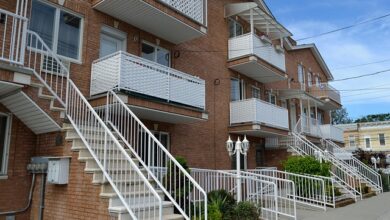How to Compare Homeowners Insurance Quotes Online in Canada

Homeownership is a significant milestone, but it also comes with responsibilities—protecting your home being one of the most important. Homeowners insurance provides financial security against unforeseen events like fires, theft, or natural disasters. However, finding the right policy at an affordable price can be overwhelming. Thankfully, comparing homeowners insurance quotes online has made this process easier and more efficient than ever before. In this guide, we’ll walk you through the steps to effectively compare homeowners insurance quotes online in Canada.
Why Compare Homeowners Insurance Quotes Online?
Before diving into the comparison process, let’s explore why doing so online is advantageous:
- Time-Saving : Instead of contacting multiple insurers individually, online tools allow you to request and compare quotes in minutes.
- Cost Transparency : Online platforms often display premiums side-by-side, making it easy to identify the best deal.
- Access to Discounts : Many insurers offer exclusive online discounts for customers who purchase policies digitally.
- Wide Range of Options : You can explore offerings from both major insurers and smaller providers, ensuring you find the perfect fit for your needs.
While convenience is key, it’s crucial to approach the process strategically to ensure you’re not compromising on coverage quality.
Step 1: Understand Your Coverage Needs
The first step in comparing homeowners insurance quotes is understanding what type of coverage you need. Homeowners insurance typically includes several components:
1. Dwelling Coverage
- Protects the structure of your home (walls, roof, foundation) against covered perils such as fire, windstorms, or vandalism.
- Ensure the coverage amount matches the cost to rebuild your home, not its market value.
2. Personal Property Coverage
- Covers your belongings (furniture, electronics, clothing) if they’re damaged, stolen, or destroyed.
- Consider whether you need additional endorsements for high-value items like jewelry or art.
3. Liability Protection
- Shields you from lawsuits if someone is injured on your property or if you accidentally cause damage to others.
- Higher liability limits provide greater peace of mind.
4. Additional Living Expenses (ALE)
- Pays for temporary housing and other expenses if your home becomes uninhabitable due to a covered loss.
5. Optional Endorsements
- Depending on your location, you may want endorsements for risks like water damage, earthquakes, or sewer backups.
Take inventory of your home’s features, valuables, and potential risks to determine the level of coverage you require.
Step 2: Gather Necessary Information
To obtain accurate quotes, you’ll need to provide detailed information about your home and personal circumstances. Have the following details ready:
- Home Details : Square footage, year built, construction materials, roof type, and any recent renovations.
- Location : Proximity to fire stations, flood zones, or areas prone to natural disasters.
- Security Features : Smoke detectors, burglar alarms, smart home devices, or monitored security systems.
- Claims History : Any past claims filed on the property.
- Personal Information : Age, marital status, credit score (in provinces where it’s allowed), and whether you work from home.
Accurate information ensures that quotes reflect your actual risk profile, preventing surprises later.
Step 3: Use Online Comparison Tools
One of the easiest ways to compare homeowners insurance quotes is by using online comparison platforms. These tools aggregate quotes from multiple insurers, saving you time and effort. Here’s how to use them effectively:
- Visit Reputable Platforms : Websites like LowestRates.ca, RATESDOTCA, or Kanetix allow you to enter your details once and receive quotes from several providers.
- Input Accurate Data : Provide precise information about your home and coverage preferences to get realistic estimates.
- Filter Results : Sort quotes by price, coverage level, or insurer ratings to narrow down your options.
While these tools are helpful, remember that they may not include every insurer. For a comprehensive search, visit individual insurer websites as well.
Step 4: Evaluate Coverage vs. Cost
When comparing quotes, don’t focus solely on the premium. Consider the following factors to ensure you’re getting the best value:
- Coverage Limits : Ensure the policy adequately covers the replacement cost of your home and belongings.
- Deductibles : A higher deductible lowers your premium but increases out-of-pocket costs during a claim. Choose a deductible you can comfortably afford.
- Exclusions : Review what’s not covered under each policy. For example, some policies exclude sewer backup or overland flooding unless you purchase additional endorsements.
- Claims Process : Research the insurer’s reputation for handling claims efficiently and fairly.
- Customer Service : Look for reviews or ratings to gauge the quality of customer support.
A slightly higher premium might be worth it if the policy offers superior coverage or better service.
Step 5: Look for Discounts
Many insurers offer discounts that can significantly reduce your premium. Common discounts include:
- Bundling Policies : Combine your home and auto insurance with the same provider.
- Security Systems : Install smoke detectors, burglar alarms, or monitored security systems.
- Loyalty Discounts : Stay with the same insurer for multiple years.
- New Home Discounts : Newer homes often qualify for reduced rates due to modern safety features.
- Claims-Free Discount : If you haven’t filed a claim in several years, you may be eligible for a discount.
Ask insurers about available discounts and factor them into your decision-making process.
Step 6: Check Insurer Reputation and Ratings
Before finalizing your choice, research the insurer’s reputation. Look for:
- Financial Stability : Check ratings from agencies like A.M. Best or Moody’s to ensure the insurer can pay claims.
- Customer Reviews : Read feedback from current or past policyholders to assess satisfaction levels.
- Claim Settlement Ratio : This indicates how efficiently the insurer settles claims.
Reputable insurers like Intact Insurance, TD Insurance, and Desjardins are widely trusted in Canada, but smaller regional providers may also offer competitive rates.
Step 7: Customize Your Policy
Once you’ve narrowed down your options, customize your policy to suit your needs. For example:
- Add endorsements for specific risks relevant to your area (e.g., earthquake coverage in British Columbia).
- Increase liability limits if you frequently host guests or operate a business from home.
- Opt for extended replacement cost coverage to account for rising construction costs.
Customization ensures your policy aligns with your unique situation and provides adequate protection.
Step 8: Finalize Your Purchase
After selecting the best quote, complete the application process online. Follow these tips:
- Double-Check Details : Verify all information for accuracy to avoid issues during claims.
- Review Terms and Conditions : Understand exclusions, renewal terms, and cancellation policies.
- Make Your First Payment : Most insurers require an initial payment to activate the policy.
- Save Documentation : Keep digital and physical copies of your policy for reference.




